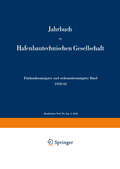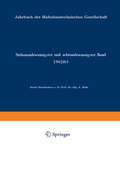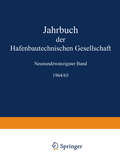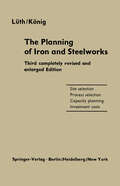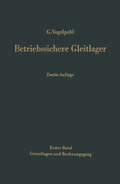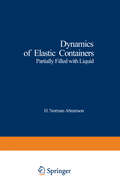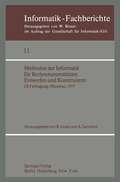- Table View
- List View
Preßwerkzeuge in der Kunststofftechnik (Chemie, Physik und Technologie der Kunststoffe in Einzeldarstellungen #4)
by Walter Bucksch H. BriefsKunststoffe. Struktur, physikalisches Verhalten und Prüfung: Erster Band: Struktur und physikalisches Verhalten der Kunststoffe (Chemie, Physik und Technologie der Kunststoffe in Einzeldarstellungen #6)
by Karl A. Wolf Rudolf NitscheAkustik II / Acoustics II (Handbuch der Physik Encyclopedia of Physics #3 / 11 / 2)
by R. W. Leonard A. Barone Rohn Truell Charles Elbaum B. E. NoltingkDie Belastungsverhältnisse in Füllkörpersäulen unter Destillationsbedingungen (Verfahrenstechnik in Einzeldarstellungen #13)
by Hermann Stage Kalyanmoy BoseTechnisch-wissenschaftliche Abhandlungen der Osram-Gesellschaft (Technisch-wissenschaftliche Abhandlungen der OSRAM-Gesellschaft #8)
by A. LompeLinearized Analysis of One-Dimensional Magnetohydrodynamic Flows (Springer Tracts in Natural Philosophy #1)
by Roy M. GundersenMagnetohydrodynamics is concerned with the motion of electrically conducting fluids in the presence of electric or magnetic fields. Un fortunately, the subject has a rather poorly developed experimental basis and because of the difficulties inherent in carrying out controlled laboratory experiments, the theoretical developments, in large measure, have been concerned with finding solutions to rather idealized problems. This lack of experimental basis need not become, however, a multi megohm impedance in the line of progress in the development of a satisfactory scientific theory. While it is true that ultimately a scientific theory must agree with and, in actuality, predict physical phenomena with a reasonable degree of accuracy, such a theory must be sanctioned by its mathematical validity and consistency. Physical phenomena may be expressed precisely and quite comprehensively through the use of differential equations, and the equations formulated by LUNDQUIST and discussed by FRIEDRICHS belong to a class of equations particularly well-understood and extensively studied. This class includes, in fact, many other eminent members, the solutions of which have led to results of far-reaching scientific and technological application. Frequently, the mathematical analysis has provided the foundations and guidance necessary for further developments, and, reciprocally, the physical problems have provided, in many cases, the impetus for the development of new mathematical theories which often have evolved to an a priori unpredictable extent.
Acryl- und Methacrylverbindungen (Chemie, Physik und Technologie der Kunststoffe in Einzeldarstellungen #9)
by Harald Rauch-Puntigam Theodor VölkerElectrical Instruments / Elektrische Instrumente (Handbuch der Physik Encyclopedia of Physics #4 / 23)
by Anton E. PannenborgThe Planning of Iron and Steelworks
by Friedrich A.K. Lüth Horst KönigAt the present time, we are witnessing a period of vigorous growth in the iron and steel industries of the older industrialised countries. Looking farther afield, we find that iron and steel indus tries are also being established in countries that have in recent years gained their independence, countries that hitherto had no iron and steelworks at all, or none of any great significance. This situation produces a certain diversity in the planning and building of iron and steelworks. In the first case, high-capacity iron and steelworks are built on the basis of conventional, tried-and tested processes, or existing plant is extended; in the second case, considerably smaller works have to be planned, and very often newer or unorthodox metallurgical processes must be used to cater for the specific raw materials available to the country in question. Following this change in the tasks of the planning engineer, and in view of the new iron and steelmaking methods developed in the meantime, the decision was taken to revise and enlarge F. LUTH's "Planung und Bau von Hiittenwerken", the first and second editions of which were published in the German language by the Springer Verlag in 1955 and 1957 respectively. In addition, the services of a second well-known expert in this field were secured for the preparation of the revised edition.
Dynamics of Elastic Containers: Partially Filled with Liquid (Applied Physics and Engineering #5)
by I.M. RapoportThe motions of liquids in moving containers constitute a broad class of problems of great practical importance in many technical fields. The influence of the dynamics of the liquid on the motions of the container itself is a most interesting and complex aspect of the general subject, whether one considers only the rigid-body motions of the container or its elastic motions as well. It is most fitting therefore that this translation of Professor Rapoport's book has been undertaken so promptly following its original publication, so as to make readily available this rather detailed account of the mathematical foundations underlying the treatment of such prob lems. Since most of this vast body of analysis has been developed over the past decade by scientists in the USSR, and has therefore been largerly unavailable to those unable to read Russian, this volume will undoubtedly be of great value to many of us. H.
Jet, Rocket, Nuclear, Ion and Electric Propulsion: Theory and Design (Applied Physics and Engineering #7)
by W.H.T. LohDuring the last decade, rapid growth of knowledge in the field of jet, rocket, nuclear, ion and electric propulsion has resulted in many advances useful to the student, engineer and scientist. The purpose for offering this course is to make available to them these recent advances in theory and design. Accordingly, this course is organized into seven parts: Part 1 Introduction; Part 2 Jet Propulsion; Part 3 Rocket Propulsion; Part 4 Nuclear Propulsion; Part 5 Electric and Ion Propulsion; Part 6 Theory on Combustion, Detonation and Fluid Injection; Part 7 Advanced Concepts and Mission Applications. It is written in such a way that it may easily be adopted by other universities as a textbook for a one semester senior or graduate course on the subject. In addition to the undersigned who served as the course instructor and wrote Chapter I, 2 and 3, guest lecturers included: DR. G. L. DUGGER who wrote Chapter 4 "Ram-jets and Air-Aug mented Rockets," DR. GEORGE P. SUTTON who wrote Chapter 5 "Rockets and Cooling Methods," DR . . MARTIN SUMMERFIELD who wrote Chapter 6 "Solid Propellant Rockets," DR. HOWARD S. SEIFERT who wrote Chapter 7 "Hybrid Rockets," DR. CHANDLER C. Ross who wrote Chapter 8 "Advanced Nuclear Rocket Design," MR. GEORGE H. McLAFFERTY who wrote Chapter 9 "Gaseous Nuclear Rockets," DR. S. G. FORBES who wrote Chapter 10 "Electric and Ion Propul sion," DR. R. H. BODEN who wrote Chapter 11 "Ion Propulsion," DR.
Physical Constants of Linear Homopolymers (Chemie, Physik und Technologie der Kunststoffe in Einzeldarstellungen #12)
by Otis G. LewisThis book is a compilation of some fundamental properties of polymers, arranged alphabetically in one table. It should prove useful in practical applications of polymers and in the development of theories of polymer behavior. Much of the impetus for studies of new polymers derives from the desire to understand how molecular structure in fluences physical properties. A large quantity of data has been generated in pursuit of this goal, and certain consistent trends have been discovered. It is hoped that further progress in this area will be accelerated by bringing together the published data on polymers in this form. The physical properties listed were selected for the following reasons. Firstly, they are fundamental quantities from which other properties may be deduced. Secondly, they can be determined reproducibly in different laboratories, and finally, they have been reported for a sufficient number of polymers to justify inclusion. The table of polymers has been arranged so as to economize on space, to keep the size of the book within reasonable proportions, and to facilitate scanning. The device of inverting the names tends to group similar compounds to aid in searching. Because of the ease with which the table can be surveyed it was felt that supplementary indexes by melting point or glass temperature would be unnecessary. References are given to the literature cited, but unfortunately it is not possible to indicate the reference next to each datum without greatly expanding the size of the table.
Jahrbuch der Hafenbautechnischen Gesellschaft: 1966/68 (Jahrbuch der Hafenbautechnischen Gesellschaft #30 /31)
by R. Schwab W. BeckerTechnisch-wissenschaftliche Abhandlungen der Osram-Gesellschaft (Technisch-wissenschaftliche Abhandlungen der OSRAM-Gesellschaft #10)
by Arved LompeChemie der Pflanzenschutz- und Schädlingsbekämpfungsmittel (Chemie der Pflanzenschutz- und Schädlingsbekämpfungsmittel #1)
by Richard WeglerCarrier Communication over Power Lines
by Heinrich-K. PodszeckCarrier communication over power lines, like carrier traffic over postal lines, has a tradition of about 50 years. It has become a vital element in electric system operation. Being restricted to power networks, it has a comparatively limited scope. Nevertheless, great efforts are being ex to keep pace with the demands made pended on technical advancement of both power and communication engineering. As in previous editions of this book, it is endeavored in the fourth edition to familiarize the man in the field with the fundamental concepts on which this technique and its practical application are based. The physical and electrical characteristics of the equipment involved are de scribed in a general way. For the sake of clarity, the author has refrained from giving a detailed account or illustrations of special versions, espe cially as the differences between the equipment supplied by the various manufacturers are so small. This is due to the use of transistors instead of tubes and to the universally adopted plug-in module construction technique. In the load dispatching plants of power supply networks, tele metering systems are turning more and more to data engineering methods and equipment to lighten the task of network management. Consequently, at certain points in the text, topics concerning remote data processing are treated, emphasis being placed on transmission channels operating at a considerably higher speed than was usual 10 years ago.
Satellite Dynamics: Symposium São Paulo/Brazil June 19–21, 1974 (IUTAM Symposia)
by G. E. O. Giacaglia A. C. SticklandThis volume includes original papers presented at the 4th Symposium on Satellite Dynamics held at the XII Annual Plenary Meeting of COSPAR. At a time where it might be thought that very few problems were left un solved in celestial mechanics, we discover that new and more challenging questions must be answered. The pre cision of observations reaches the centimeter level and physical phenomena which had been disregarded come into play. We need a better treatment of atmospheric drag, radiation forces, and a better knowledge of the earth's gravitational field. Time has to be precisely defined as well as reference systems, including improved values for precision and nutation. The question of resonances introduced by nonzonal harmonics was to be carefully in vestigated. Numerical integration techniques must be optimized and means of controlling their errors improved. Analytical techniques must be made appropriate for com puter processing. Presently existing methods of solu tions of differential equations of interest to celestial mechanics are getting cumbersome as all these new facts come to light. It is clear that entirely new and more effective methods are necessary. These methods must, among other requirements, take into account the essential nonlinear character of the equations. Finally, the mo tion about the center of mass of a satellite is becoming an essential need for the thorough understanding and de scription of the orbital motion.
Methoden der Informatik für Rechnerunterstütztes Entwerfen und Konstruieren: GI-Fachtagung, München, 19.–21. Oktober 1977 (Informatik-Fachberichte #11)
by R. Gnatz K. SamelsonTurbulent Shear Flows I: Selected Papers from the First International Symposium on Turbulent Shear Flows, The Pennsylvania State University, University Park, Pennsylvania, USA, April 18–20, 1977
by F. Durst B. E. Launder F. W. Schmidt J. H. WhitelawThe present book contains papers that have been selected from contributions to the First International Symposium on Turbulent Shear Flows which was held from the 18th to 20th April 1977 at The Pennsylvania State University, University Park, Pennsylvania, USA. Attend ees from close to 20 countries presented over 100 contributions at this meeting in which many aspects of the current activities in turbulence research were covered. Five topics received particular attention at the Symposium: Free Flows Wall Flows Recirculating Flows Developments in Reynolds Stress Closures New Directions in Modeling This is also reflected in the five chapters of this book with contributions from research workers from different countries. Each chapter covers the most valuable contributions of the conference to the particular chapter topic. Of course, there were many additional good con tributions to each subject at the meeting but the limitation imposed on the length of this volume required that a selection be made. The realization of the First International Symposium on Turbulent Shear Flows was p- sible by the general support of: U. S. Army Research Office U. S. Navy Research Office Continuing Education Center of The Pennsylvania State University The conference organization was carried out by the organizing committee consisting of: F. Durst, Universitat Karlsruhe, Karlsruhe, Fed. Rep. of Germany V. W. Goldschmidt, Purdue University, West Lafayette, Ind. , USA B. E. Launder, University of California, Davis, Calif. , USA F. W. Schmidt, Pennsylvania State University, University Park, Penna.



